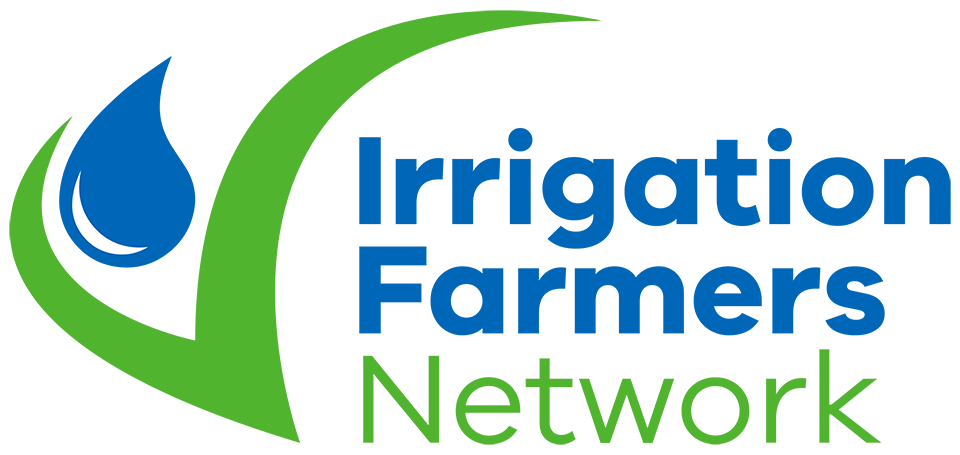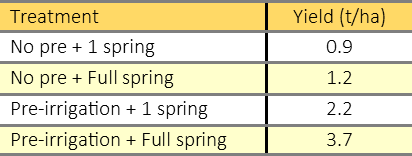Irrigation Trials
2020 Results
In 2020 ICC are collaborating on the Smarter Irrigation for Profit – Phase 2 project. This project will address the challenge of reduced water availability by improving the water productivity of Australian cropping and pasture irrigators. It will do this by developing new precision irrigation technologies, improving existing technologies and facilitating faster uptake through producer led demonstration sites. Smarter Irrigation for Profit – Phase 1 found participating Australian irrigators could achieve a 10-30 percent improvement in water productivity by adopting precision irrigation technologies.
2019 Results
Objectives
- Evaluate pre-irrigation and spring irrigation strategies on a range of crop types and maturities to calculate the best return for irrigation water.
- Establish crop yield potentials based on the level of irrigation input.
Results
Pre-irrigation assisted with better establishment, plant vigour and weed control. Despite above average rainfall for May and average for June and July, the soil moisture did not improve below 200mm. This also saw a period of soil moisture stress in mid June which affected crop nutrition and vigour. As the season progressed and rainfall dropped to below average, the developing crops quickly depleted soil moisture. No pre-irrigation treatments were irrigated on August 23rd and used a slightly lower volume of water than the pre-irrigated treatments in autumn.
These pre-irrigated areas also needed irrigation soon after on August 30th thanks to the vigorous crop growth. Maturity made little difference in yields in either the barley or canola. Maturity did affect yield in the wheat, with the late maturing DS Bennett having the highest yield in both no pre-irrigation treatments, mid-season Beckom having the highest yield in the ‘pre-irrigation + 1 spring’ and Cobra, early mid maturity, the highest yield in the ‘pre-irrigation + full spring’ treatment.
Wheat
Varieties did respond to the season differently, the short season Axe in the no pre-irrigation treatments quickly started the stem elongation phase with heads emerged by August 22nd, just prior to irrigation. Therefore, yield potential was set so irrigation could only improve grain size or begin secondary tillering, which would then requiring more than 1 irrigation to finish properly
Gross margin for the average of the 6 wheat varieties. Input costs (excluding water and urea) used in the calculation were $318/ha.
The best return was $1255/ha or $270/Ml from a pre-irrigated and 3 spring irrigations if you had allocation to use. Best return per megalitre was to not pre-irrigate and 1 spring irrigation. If you had chosen to sell your water at the time, the return from the water would have been approximately $2770.
Barley
Analysis of the yield data showed that variety made no difference to yield (p=0.481). There were varietal differences in the grain quality in response to the irrigation treatments, for details of these and the full statistical analysis, please refer to the appendix.
Barley gross margins for each irrigation strategy based on the use of allocation water at $60/Ml and buying temporary water at $500/Ml in autumn and $750 in spring. Calculated using a grain price of $291/t and input costs (excluding water and urea) of $227/ha
Canola
Although three varieties of canola were sown with different maturities, the yield data showed variety to be not significant (p=0.884). Therefore our analysis has disregarded variety.
The best return was $1463/ha or $390/Ml from pre plus full spring irrigation. If you had chosen to sell your water at the time, the return from the water would have been approximately $2150. Canola gross margins, calculated using a grain price of $605/t and total inputs (excluding water and urea) cost of $271/ha
Faba Beans
Pre-irrigation allowed for better establishment and winter growth of the fabas but needed extra water in spring to ensure the growth resulted in beans. Samira grain yield and bean size
The best return was $1779/ha or $383/Ml from a pre-irrigated and 3 spring irrigations. If you had chosen to sell your water at the time, the return from the water would have been approximately $2770. Faba Bean gross margin calculated on a F1 grain price of $600/t due to small bean size. Input costs (excluding water) used in the calculation were $462/ha









